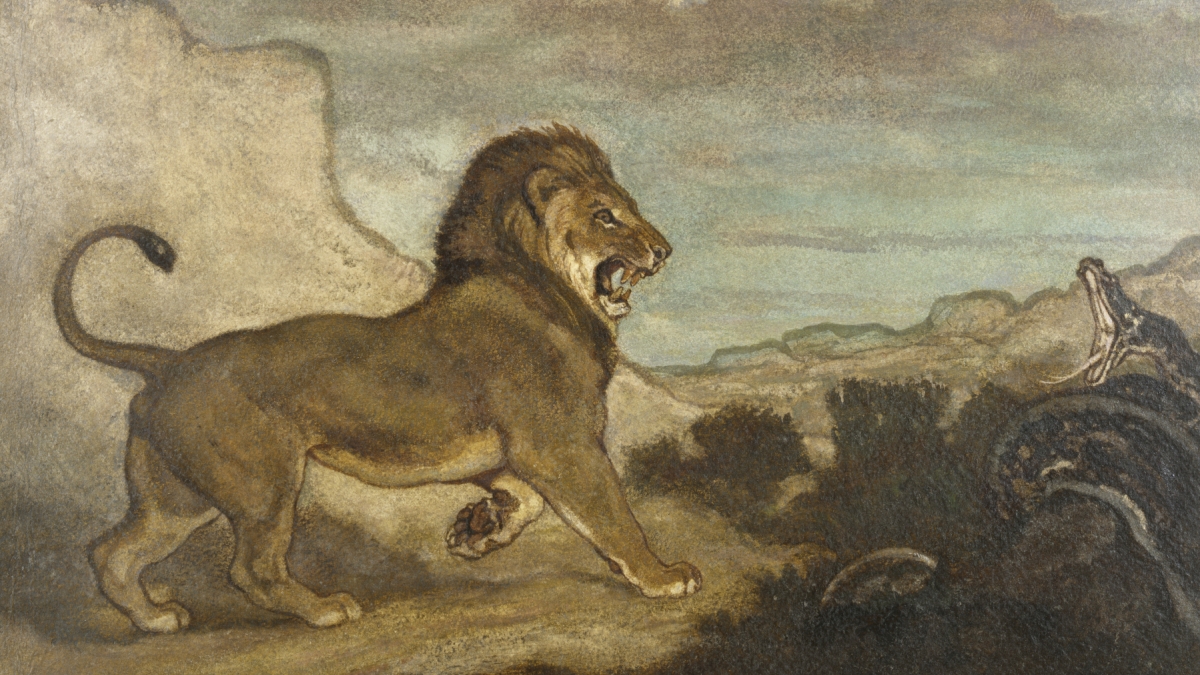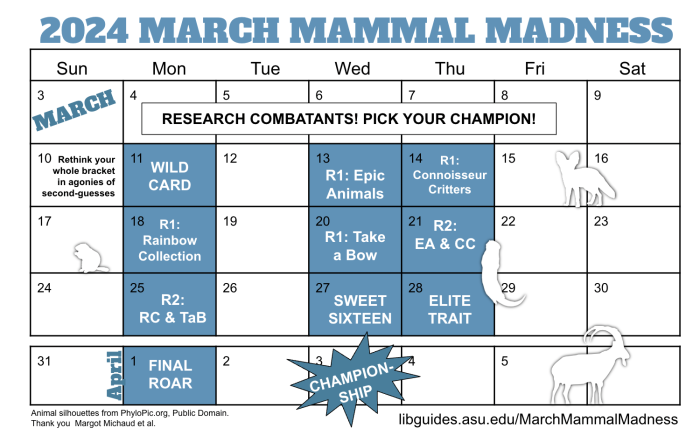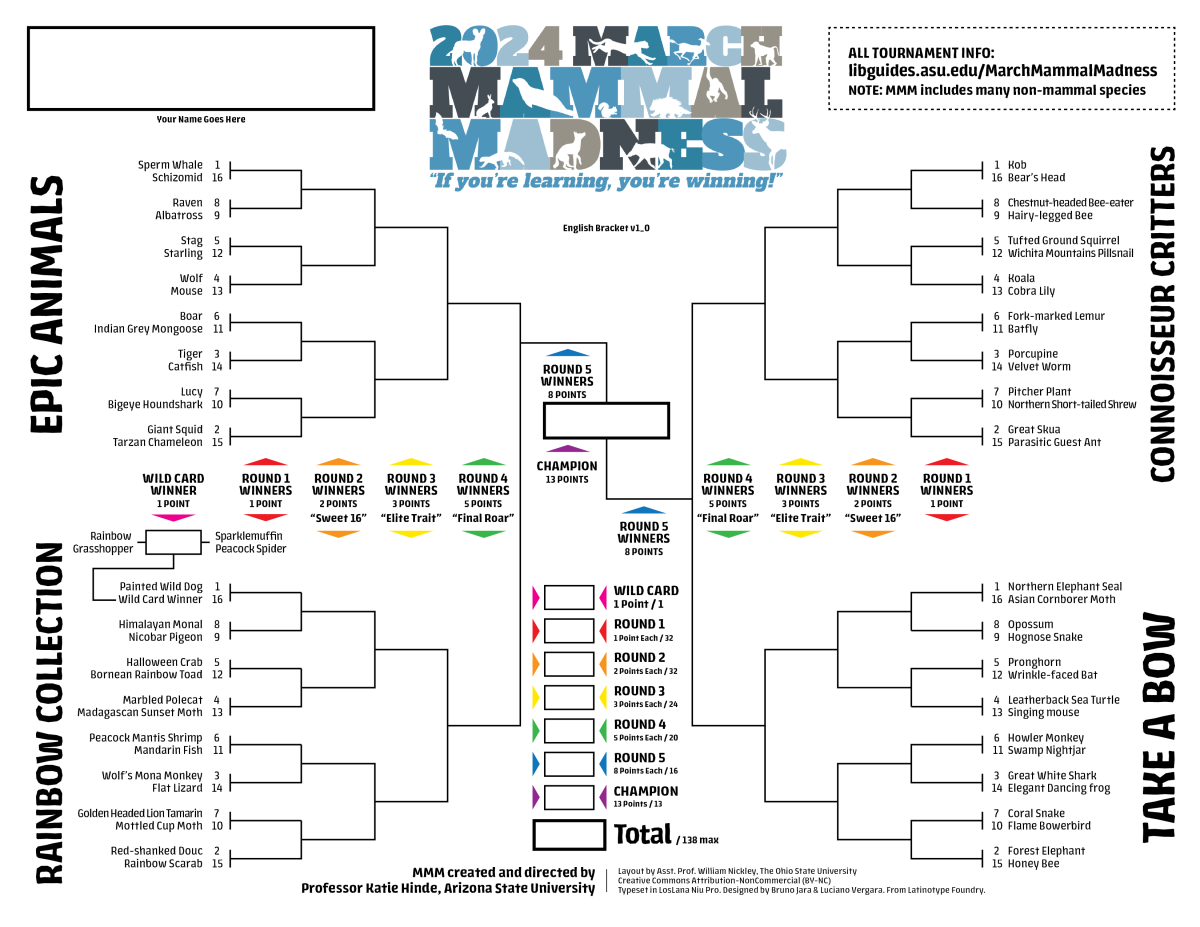2024 March Mammal Madness tournament celebrates animals, the arts

“Lion and Python” by Antoine-Louis Barye, acquired by William T. Walters, 1863 (Wikimedia Commons)
As the seasons change, the month of March brings a special excitement to the air; 65 featured combatants are poised to enter “battle,” with only one to be crowned March Mammal Madness champion.
The March Mammal Madness (MMM) tournament is back for 2024. Founded in 2013, this nature-based simulated competition, styled after the NCAA College Basketball March Madness, has been winning over players, learners and educators, growing expansively every year. This year’s tournament celebrates the arts, and the battles kick off the week of March 11.
“Humans have artistically depicted animals for tens of thousands of years. Long before canvases and computers, artists immortalized animals in rock paintings, carved wood, embroidered fabric, chiseled marble, sculpted clay, worked leather, casted metal and tattooed skin … and continue to do so today,” said Katie Hinde, associate professor in the School of Human Evolution and Social Change and the Center for Evolution and Medicine at Arizona State University. Hinde is the founder and editor-in-chief of MMM.
In 2024, each division speaks to a different facet of artistic expression, but with a twist from the natural world. Players will find combatants that fall within the themes of four new divisions: epic animals featured in literary arts; connoisseur critters with specialized diets as a play on culinary arts; rainbow collection for visual arts; and take a bow of extraordinary animal performances in nature. Within these divisions, this year’s tournament intentionally creates more space to highlight connections between nature and art.
“For years, each evening of the tournament includes an inspirational intermission, typically a quote about nature, conservation or land stewardship,” Hinde said. “Across the weeks of the tournament, we will spotlight sustainable landscape design and responsible creativity in natural ecosystems (stop stacking rocks!), and how nature and art can improve human health.”
This tournament recognizes 10 years since artist Charon Henning launched the MMM art team. In 2015, Henning and her colleagues began creating hundreds of illustrations of the MMM combatants. These illustrations contribute to a long history of artwork that enriches understanding of various animal species.
“Scientific study of the natural world has always been enhanced when paired with the creative arts,” Hinde said.
To play MMM, players can start with the ASU Library’s March Mammal Madness Library Guide, known as the MMM LibGuide. This guide brings together key information about the rules and procedures for the MMM game with an expanded guide for educators, and tips and tricks for how to use MMM in classrooms with learners.
“As online spaces become increasingly unpleasant, we are so excited that the MMM LibGuide allows folks to follow the tournament outcomes and science of the combatant encounters without having to be on social media,” Hinde said. “The player, learner and educator portals in the MMM LibGuide are a game changer, showcasing resources specifically curated for the different MMM user groups.”
With the 2024 theme of “MMM Celebrates the ARTS!”, the educator lesson plans, hosted at the LibGuide, were revamped to include more visual arts and language arts, particularly with haiku.
March Mammal Madness Library Guide
To play March Mammal Madness, check out the ASU Library’s March Mammal Madness Library Guide, where you can find:
- Key information about the rules and procedures.
- An expanded guide for educators.
- Tips and tricks for how to use MMM in classrooms with learners.
Hinde said, “As an exercise in creative writing, haiku are especially wonderful because they can be written by learners of all ages, from kindergarten to adult education. Moreover, March Mammal Madness and haiku are a phenomenal pairing: The heart of haiku involves using key words to describe physical traits and behaviors of animals or scenery and seasons in nature. Science teachers embracing STEAM (science, technology, engineering, arts and mathematics) approaches can use haiku as a way of having students think about key vocabulary and concepts in animal and ecosystem units.”
Last year, the MMM LibGuide received over 1 million page views, making it the 22nd most popular LibGuide out of 780,000 LibGuides in the United States. Hosting the MMM resources at the ASU Library’s education-friendly URL allows schools and educators to access the materials and results, which will be posted after every round.
“The MMM team is dedicated to removing barriers that historically leave behind huge groups of learners, and not just cost. MMM is free for anyone to play, but importantly, all the educational materials are also available as open educational resources,” said Anali Maughan Perry, head of Open Science and Scholarly Communication at ASU Library. “I look forward to celebrating this massive, group effort in collaborative open education and open pedagogy as educators adapt the content in the ways they want to meet the needs of their students. It’s an appropriate synergy that the tournament is always just getting underway during Open Education Week each year.”
On the eve of 2024 MMM, more than 9,500 educators from around the world plan to use the materials in their classrooms, which will reach over 870,000 learners. MMM reaches educators in all 50 states and over 4,000 cities and towns, with a footprint in half the counties in the country.
“It’s funny, but we get a little anxious when we start thinking about how many people are participating this year,” Perry said. “Knowing how many people are waiting to see the results definitely creates an adrenaline rush as we work with Katie and the rest of the team to get the results up on the LibGuide as soon as possible so it’ll be ready for educators first thing the next morning.”
Even if the tournament has already started, it’s never too late to join in. The entire schedule of events is posted on the MMM LibGuide, with the championship battle happening on April 3.
“For the first time in March Mammal Madness, every division has multiple non-mammal combatants from across the tree of life,” Hinde said. “Unlike past tournaments, when the bracket design ensured a mammal would reach the championship battle, in 2024, the championship battle may not include any mammals at all.”
Every year, MMM brings surprises and a few upsets, but most importantly, new perspectives and understanding about species some may never have heard of before.
“Surprises and twists are always a part of March Mammal Madness," Hinde said, "and with the new divisions and many unfamiliar combatants, everyone will learn something this year. And as our slogan reminds us, ‘If you’re winning, you’re learning!'”
More Arts, humanities and education

Grand Canyon National Park superintendent visits ASU, shares about efforts to welcome Indigenous voices back into the park
There are 11 tribes who have historic connections to the land and resources in the Grand Canyon National Park. Sadly, when the park was created, many were forced from those lands, sometimes at…
ASU film professor part of 'Cyberpunk' exhibit at Academy Museum in LA
Arizona State University filmmaker Alex Rivera sees cyberpunk as a perfect vehicle to represent the Latino experience.Cyberpunk is a subgenre of science fiction that explores the intersection of…

Honoring innovative practices, impact in the field of American Indian studies
American Indian Studies at Arizona State University will host a panel event to celebrate the release of “From the Skin,” a collection over three years in the making centering stories, theories and…

